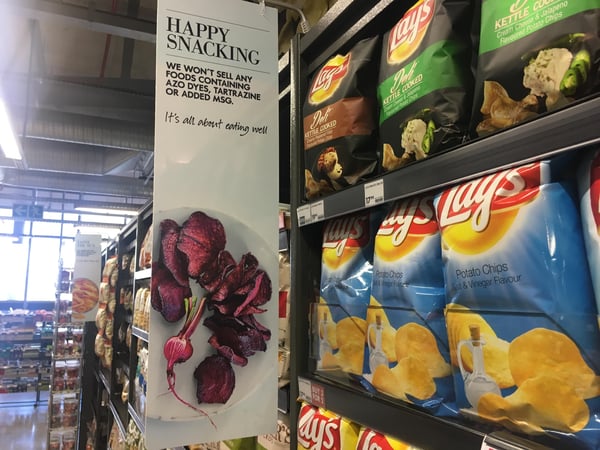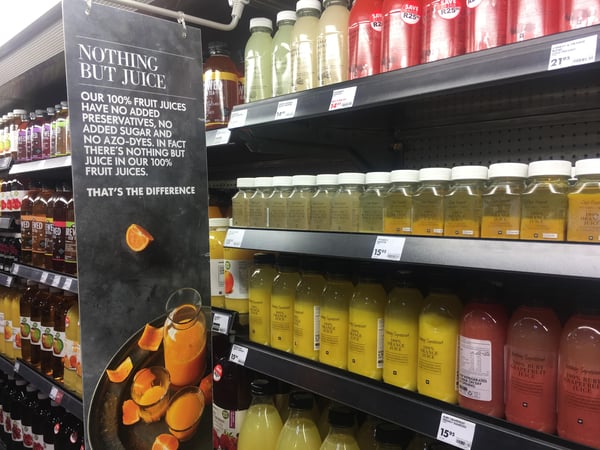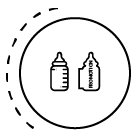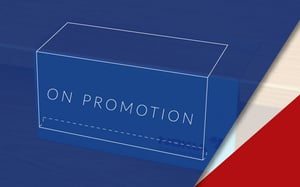As much as shelf talkers are great in-store marketing tools, they can also often look lame and kitsch. That’s especially true when each product you see on the shelf has its own talker. While your aisles might appear colorful and vibrant, they can be overwhelming for your customers.
That is not to say that retailers don’t get it right. There are plenty who understand how to use shelf talkers in a classy way that adds to their overall brand as well as their shoppers experience. There are also a few who get it wrong.

Retailers must collaborate with suppliers on shelf talkers
Considering the fact that as a retailer, you own the shelf space in your store, you need to be more upfront about deciding how to present yourselves to your customers. That includes decisions around the shelf talkers you have in your store.
More specifically, it’s first around deciding whether to place a shelf talker or not. Then, if you do decide to go ahead, you must insist on working with your supplier to craft the message that appears with it.
The reason for that is simple. Customers buy from stores (and people) they trust. Need evidence? How about this: Bob David, a sales associate at a Total Wine & More’s store in West Orange, New Jersey wrote a note for a particular Cabernet, stating it was the best Cabernet he had tasted at that price. The result? Sales rose, as the store went from selling one case a month to three a week.
Now compare that to the marketing message that the wine buying team produced. It wasn’t necessarily the worst written piece of marketing. But compared to Mr David’s note, it was cold and bland. Not many customers are going to buy the wine based off of that unless they already have a history with the particular vintage.
 The above image, as well as the two below show the power of having a consistent look and feel to your in-store shelf talkers.
The above image, as well as the two below show the power of having a consistent look and feel to your in-store shelf talkers.
That said, there is another reason why retailers and suppliers should work hand in hand. Let’s take the example of a shelf talker for adidas mens deodorant. How different would it look if you, as a retailer, co-branded the shelf talker with adidas?
Firstly, it would contribute to both yourself and the product’s brand. Secondly, by working this way will all of your suppliers, you’d provide a consistent look and feel when it comes to shelf talkers in your store.
Contrast that with a shelf talker that might be brand-on for adidas but does nothing for your store’s reputation. For shelf talkers to be truly effective, they need to contribute to both your retail brand and the product’s brand. Without collaboration between yourself and your supplier, that won’t happen.

Localise your shelf talkers according to your market
In the same way that you should localise your assortment planning, you need to also seriously consider localising your shelf talkers. In fact, it should be more of a request than a suggestion. That’s because your shelf talkers need to speak directly to your market and who they are.
Let's say you have a few stores located throughout the country, and while some are located in rich neighbourhoods, your store caters for a wide market so you’ll also have one or two in poorer communities. The marketing message on your shelf talkers that you present to your customers will thus need to differ according to the location of your store.
After all, your customers in a richer community will have different needs, wants, and means to that of your poorer customers. And you need to cater for all of them.

This also filters into the above point around collaborating with your suppliers on the message. Not only does it add to the shopper experience but it can contribute to breaking down any sales barriers that you customers may have. You’re catering for them personally, and what you're presenting resonates with them.
Besides that, there is another reason to localise your shelf talkers: uniformity. Once a certain method, design and style has proved to be effective, you should look at implementing it across all of your stores that have a similar shopper profile.
It will have the similar if not the same effect as localising your assortment planning. Satisfying your customers needs, improving their in-store experiences, and presenting the right product in the right place, with the right messaging will go a long way to pleasing them.

Design your shelf talkers around the products they’re advertising
When it comes to designing the shelf talkers for your store, you’ll find plenty of advice around what you need to include and how they need to be presented.
Darryl Rosen, a 30-year veteran in the retail business, does a great job in laying out the tips for effective shelf talkers. We’ve also written about how they’re one of the retail fixtures you should own since they can have a huge impact on your bottom line.
That said, they can also become too much if they’re not designed properly. If, however, your talkers are designed around the products they are advertising as opposed to being generic cutouts, you’re on the right track.
.jpg?width=600&name=IMG-3336%20(1).jpg)
For example, you shouldn’t expect to have the same style of cutout for an instant coffee product as you would for a new breakfast cereal that you’ve introduced to your store. Besides it being lazy, you’re not giving your customers the chance to distinguish between the two products. After a while, they’ll also skim over it, which will negate the whole purpose of that shelf talker.
Of course, there is more to shelf talkers than simply attracting attention. But, at their core, that is what they are meant to do: they are there to draw your customers in to get them to buy. They also has to be understood by everyone, from your suppliers to your store manager to those who pack your shelves. And especially your customers.
But that won’t happen if they are all designed in the same way, be that by colour, style or shape.
Conclusion
Shelf talkers can be kitsch at times. That’s when each product has their own self-servicing shelf talker, which looks different and brings nothing to the store they’re placed in. When done right, though, they can appear stylish and add value to your retail brand. It is the latter that you should always strive for as a retailer.
Are you interested in taking care of your shoppers? Then our Shopper ebook is just for you. You can download your free copy here.


